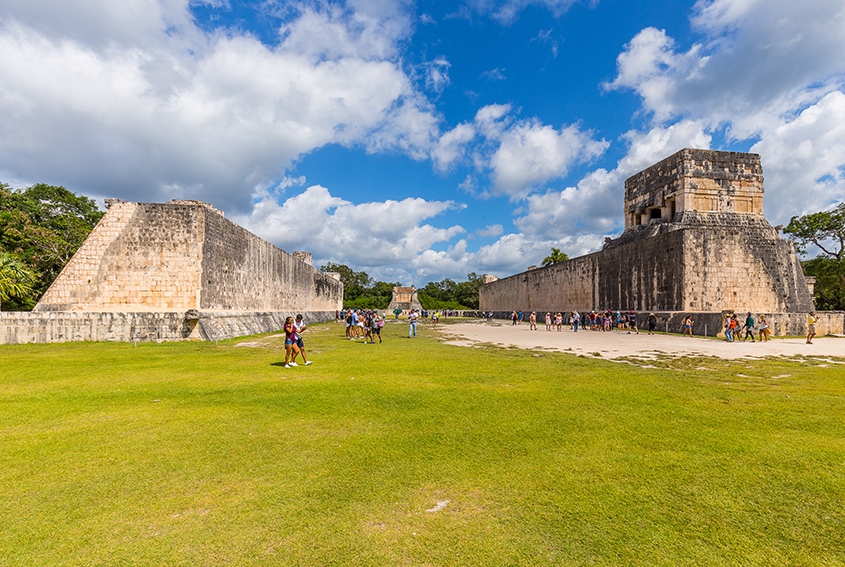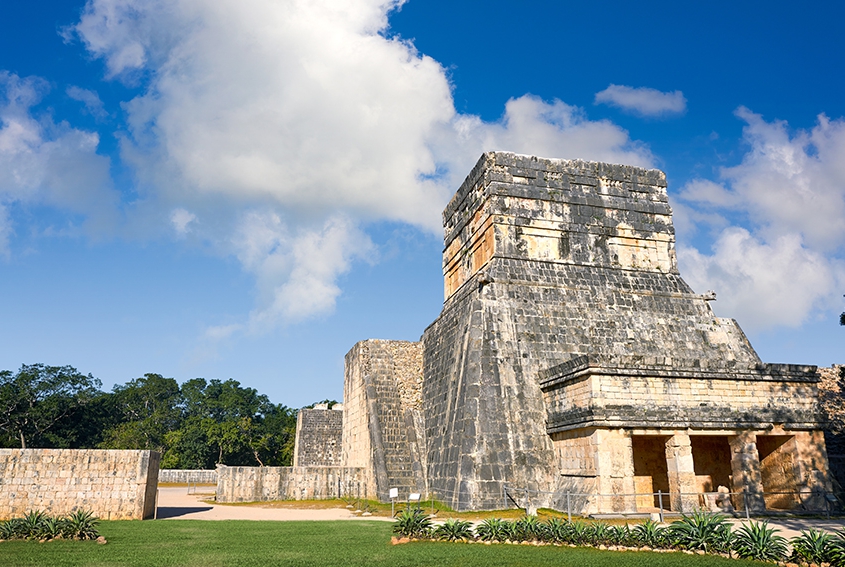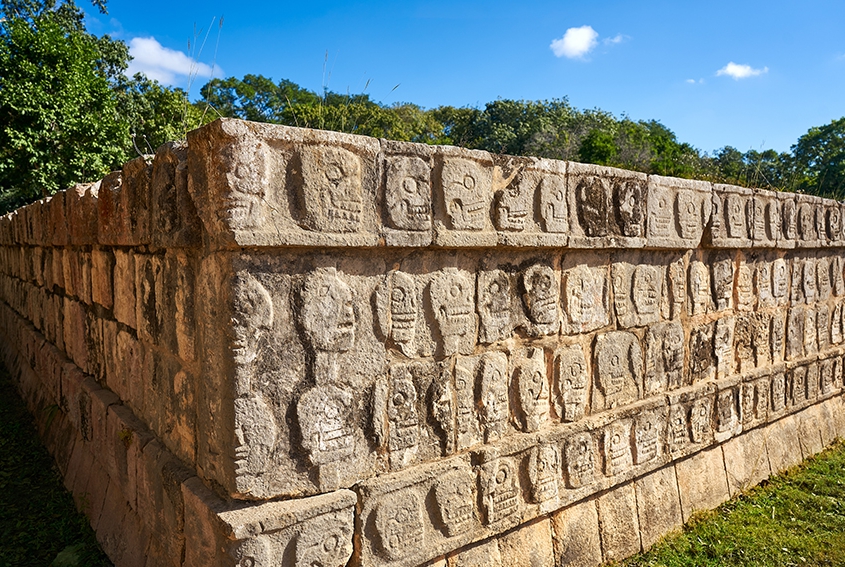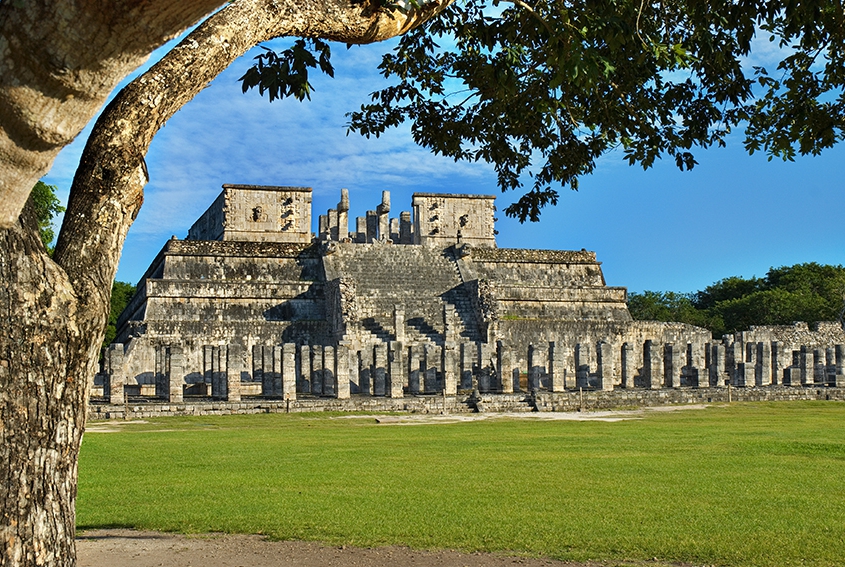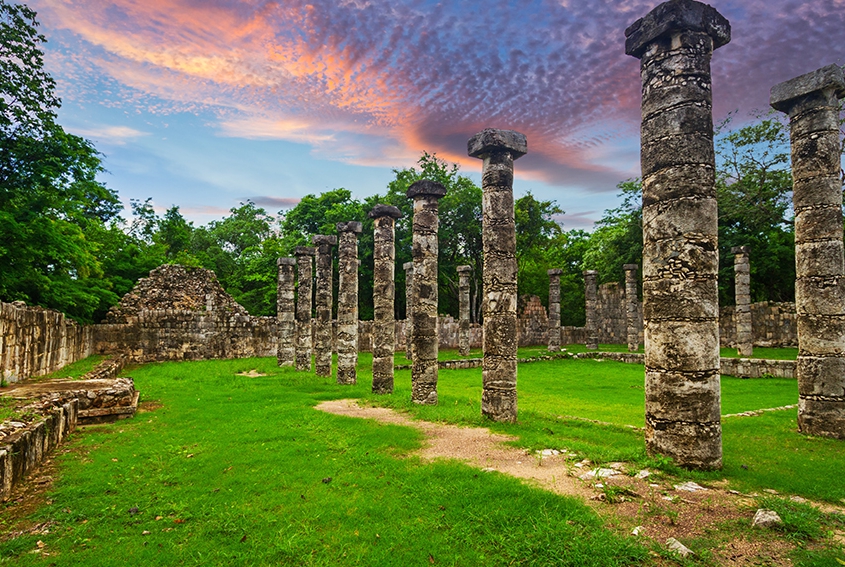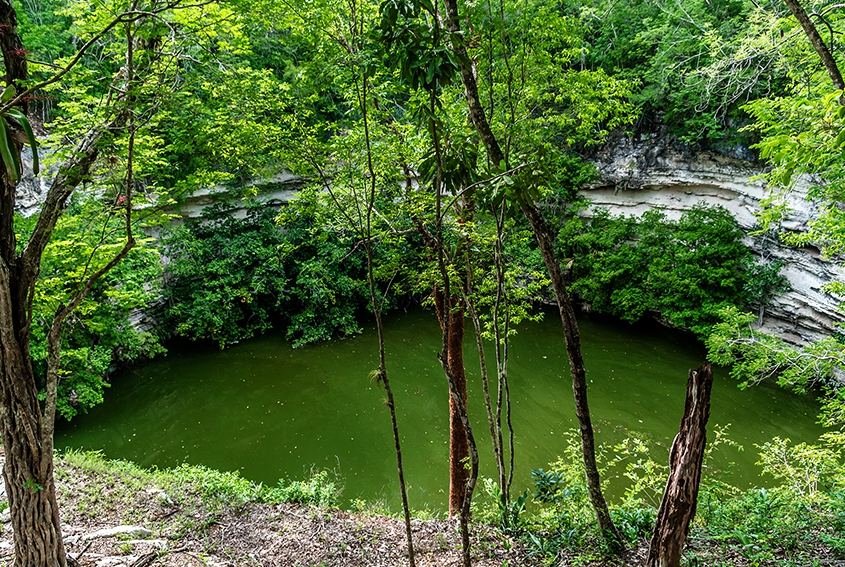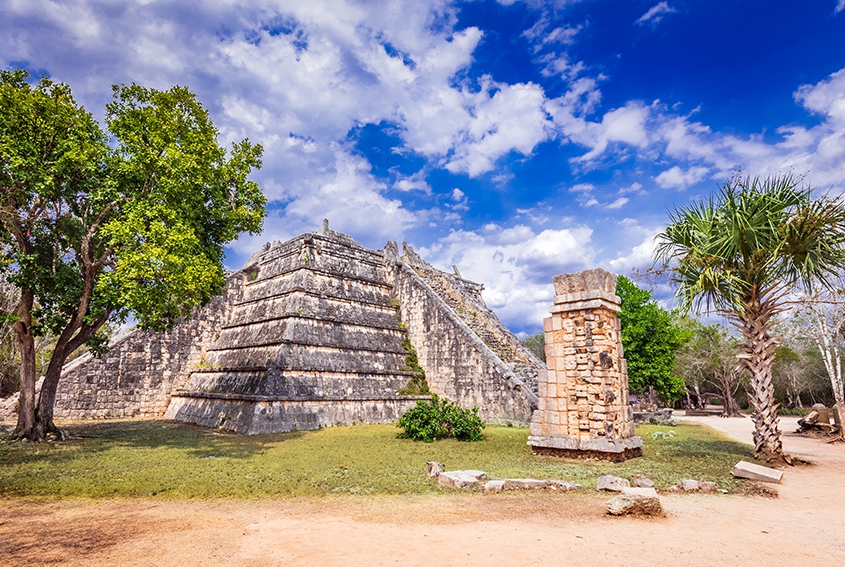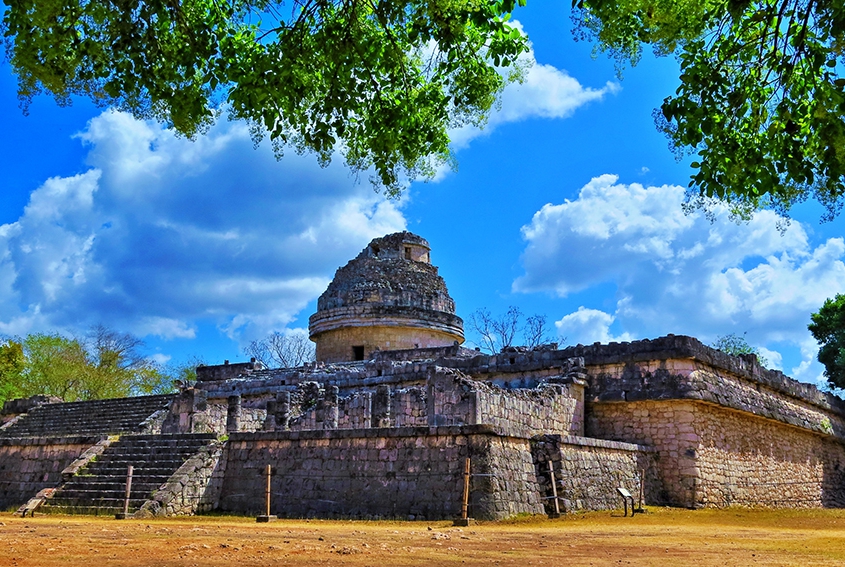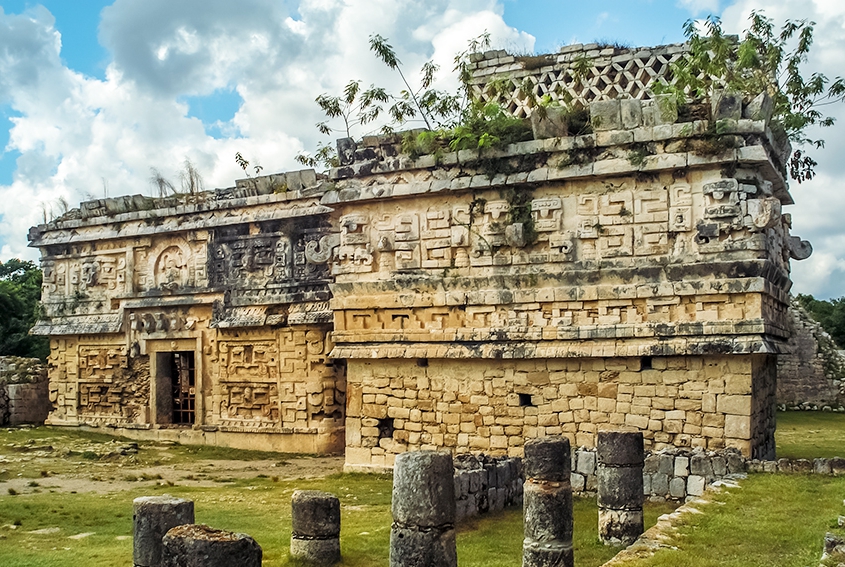The wonders of Chichen Itza
As the sun sets on the day of the autumn equinox, the Maya city of Chichen Itza welcomes an ancient god. Triangles of light and shadow form along the north staircase of the Pyramid of Kukulcan, rippling down to the carved head of a snake at the foot of the building. This creates the illusion of an immense serpent slithering down from the heavens. The Maya believe that it is Kukulcan, the feathered serpent god also worshipped in central Mexico as Quetzalcoatl, and that he is returning to earth to give hope to his followers. This awe-inspiring spectacle is just one of the wonders at Chichen Itza. How about planning a visit this month to learn more?
In ancient times Chichen Itza was a powerful city stretching over an area of 15 square kilometers. To date, only three percent of this vast archaeological site is open to the public. The famous Pyramid of Kukulcan, the Observatory and the surrounding temples earned Chichen its place on the UNESCO World Heritage list, and archaeologists continue to excavate temples and palaces in the forest. They have discovered residential neighborhoods, evidence of ancient cacao plantations, fields and wells, a network of sacbes or roads and the vestiges of defensive walls around the sacred center of the city.
A little history
Chichen’s earliest temples date from between AD 600 and 800 and were built in the Maya Puuc architectural style and decorated with curl-snouted masks of the rain god Chaac. Between AD 967 and 987, the city was overrun by the Itzae, conquering warriors from the west who brought a different building style and art. They had links with cultures in Central Mexico and their bas-reliefs depict serpents, eagles and jaguars devouring hearts, warriors and skulls.
At the height of its glory, the great metropolis of Chichén Itzá controlled the Yucatán politically, commercially and militarily. The city was abandoned by 1250, but when conquistador Francisco de Montejo, explored the ruins in the 16th century he was so impressed that he considered making it his capital.
Exploring Chichen
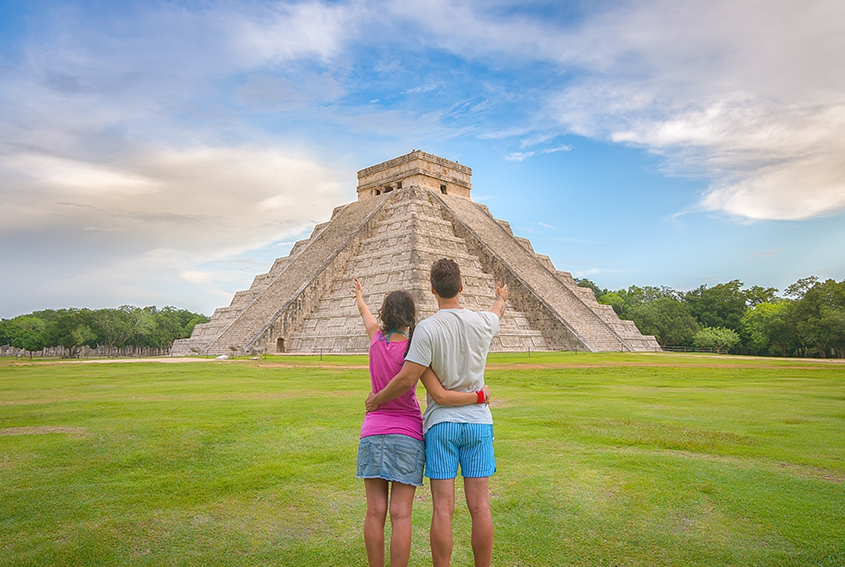
Pyramid of Kukulcan
Wherever you are, your eye is drawn to the towering Pyramid of Kukulcan or El Castillo at the heart of the sacred plaza, a symbol of ancient power. The building we see today was constructed by Itzae rulers between AD 1050 and 1300. However, studies using remote sensing technology have shown that there are three temples on the site, the earliest built between AD 550 and 800 on top of a cave containing a cenote. Later rulers erected their own monuments around it to channel sacred energy.
The 25-meter-high pyramid is a solar clock, so precisely aligned to catch the rays of the setting sun on the spring and fall equinoxes in March and September. The apparition of the mysterious serpent figure is testimony to the skill of ancient astronomers and architects and for the Maya it heralded the start of the spring planting season and the fall harvest.
Deep inside the pyramid, archaeologists discovered a temple containing a reclining chac mool statue with its hands cupped to receive a sacrifice and a majestic red jaguar throne with jade eyes and spots.
The pyramid is between four cenotes or sinkholes found at the site, as though it were the center of the universe. In addition to being the only source of fresh water in the area, cenotes and caves were holy places, considered the gateway to Xibalbá, the Underworld, the realm of the gods. The name Chichén Itzá means “mouth of the well of the Itzaes.”
The Ball Court
The Ball Court in the Great Plaza is the largest in the Maya World. It was here that the Maya played a fast-moving ball game in which teams of warriors had to get a rubber ball through a stone ring high up on the wall of the court with their elbows, wrists and hips without kicking it or using their hands. Priests and nobles would watch the game from the viewing platform in the South Temple.
The ball game had religious and mythological overtones and was linked to the eternal battle between light and darkness, good and evil, death and rebirth. The carved panels on the court walls show warriors, ball players in full regalia and the ritual decapitation of one of the team captains.
The acoustics in the ball court are incredible – you can literally stand at one end and clap and be heard by someone standing at the other end, 146 meters away.
The Temple of the Jaguars
The jaguar or balam was a sacred animal for the Maya; it was the bearer of the sun on its nightly journey through the Underworld and was associated with war on account of its ferocity and strength. It comes as no surprise that the jaguar was venerated in the warlike city of the Itzae and that it even has a temple to honor it.
Jaguars, Mayan and “Toltec” warriors, feathered serpents and even a battle scene appear in the friezes in the upper and lower temples. The lower temple also has a jaguar throne.
Tzompantli
This low platform in the Great Plaza was a skull rack upon which the heads of sacrificial victims or captives were displayed. The wall carvings have a military theme and show skulls, warriors, serpents and eagles devouring hearts.
Temple of the Warriors
Built on top of an earlier temple called Chac Mool, the massive Temple of the Warriors is famous for its columns covered with carvings of warriors and priests; panels featuring Kukulcán emerging from the jaws of a snake, jaguars and eagles devouring hearts, a mural showing an attack on a coastal village by seagoing warriors in canoes, Atlantes figures, standard bearers, and a Chac Mool statue on the upper level surrounded by feathered serpent pillars that once supported the temple roof. The architecture is a blend of Mayan and central Mexican elements.
The Court of a Thousand Columns
The colonnades in front of and to the south of the Temple of the Warriors were originally covered with a wooden roof and may have been halls that were used during ceremonies or for gatherings during which nobles discussed city policy. The colonnade extending from the front of the Temple of the Warriors to the northwest consists of 221 pillars, each one carved with a unique portrait of a warrior, priest, noble and captives. The courtyard formed by these walkways housed ball courts, temples, steam baths and the Mercado or Market, also thought to have been the site of the Popol Nah or council chamber.
The Sacred Well
A short walk from the Great Plaza along a sacbe is the Sacred Cenote, a deep sinkhole that was once the site of sacrificial ceremonies to appease Chaac, the rain god.
The cenote was dredged during excavations in the past and yielded up over 30,000 artifacts including gold, jade, turquoise, pottery and the bones of around 200 people, mostly children and old men.
The Ossuary
Also known as the Tomb of the High Priest in reference to the burials found in a cave under the pyramid, the Ossuary was built during the 9th century. The wall carvings feature serpents, birds with the face of Itzamna, the chief god in the Mayan pantheon, cacao, fruit, Chaac masks and images of Kukulcan.
Following the path to the Observatory you’ll see the House of the Deer and the Casa Colorada or Chichanchob, two of the site’s earlier buildings. Archaeologists are currently studying hieroglyphic inscriptions found at the Casa Colorada.
The Observatory
El Caracol, also known as the Observatory, is a round tower on a square platform that was used by ancient Mayan priests and astronomers to study the heavens. It has a viewing platform and wells to mirror starlight and was aligned to catch sunsets and moonsets on both equinoxes and to mark the course of Venus. Round towers are rare in the Maya World and are a central Mexican innovation. Archaeologists have discovered that the Observatory had at least six building phases.
Maya Chichen
The cluster of buildings located to the south of the Observatory were built during the period AD 600-900 in the Puuc architectural style typical of southwestern Yucatan and characterized by elaborate friezes featuring curl snouted masks of Chaac, the rain god. The largest building is Las Monjas, which had seven building phases and was christened “The Nunnery” by Diego de Landa because it resembled the convents of Spain. The East Annex and La Iglesia (the Church) are smaller buildings with magnificent upper friezes.
In the forest beyond Las Monjas lies the area known as Chichén Viejo and the earliest buildings such as the Temple of the Initial Series, Casa de los Caracoles and the Temple of the Owls. A trail linking some of these groupings will soon be inaugurated, revealing more of Chichén’s secrets.
Ask your Concierge about Chichen Itza trips
Your Concierge can help you plan a trip to Chichen Itza. Some day trips include visits to the colonial town of Valladolid and cenote swims, or you can arrange a private tour with your own guide or rent a car and explore at your own pace

